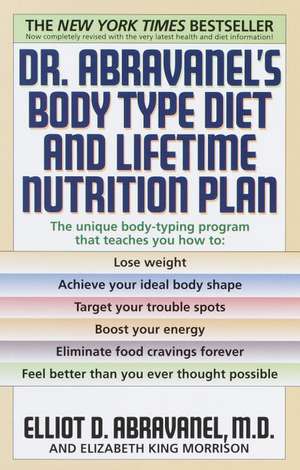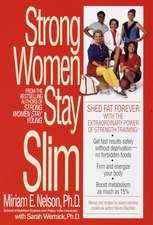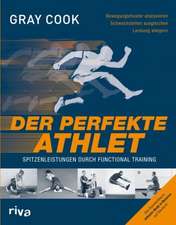Dr. Abravanel's Body Type Diet and Lifetime Nutrition Plan
Autor Elliot D. Abravanel, Elizabeth King Morrisonen Limba Engleză Paperback – 30 iun 1999
Lose weight
Achieve your ideal body shape
Target your trouble spots
Boost your energy
Eliminate food cravings forever
Feel better than you ever thought possible
Do you crave coffee and sweets--or a nice thick steak?
Do you get love handles--or jiggly pockets on your thighs?
Are you quick-tempered--or impatient and easily depressed?
Believe it or not, your answers to these and other questions posed in this breakthrough book will help you discover which of the four basic "Body Type" categories you fall into--the first step toward determining what you need to do to lose weight and look and feel better than ever.
More than just a diet, Dr. Abravanel's one-of-a-kind plan is a complete health, fitness, and nutrition program that first teaches you how to determine your body type and then custom-tailors a three-step weight-loss plan and exercise regimen just for you. Using the latest scientific research, Dr. Abravanel has revised and expanded this successful strategy to make it even more effective and easy to follow.
This revolutionary program includes:
A newly revised Body Type questionnaire you can do at home
A detailed list of foods you should avoid--and those you must eat
A four-week eating plan, complete with daily menus and recipes
A guide to supplements, herbal remedies, and exercise routines for each Body Type
A Long Weekend of Rejuvenation to purify your system and clear your mind
Now, to find out which Body Type you fall into, turn to the first page....
Preț: 108.28 lei
Nou
Puncte Express: 162
Preț estimativ în valută:
20.72€ • 21.75$ • 17.20£
20.72€ • 21.75$ • 17.20£
Carte disponibilă
Livrare economică 20 martie-03 aprilie
Preluare comenzi: 021 569.72.76
Specificații
ISBN-13: 9780553380415
ISBN-10: 0553380419
Pagini: 384
Dimensiuni: 135 x 206 x 20 mm
Greutate: 0.3 kg
Ediția:Revised
Editura: Bantam Books
ISBN-10: 0553380419
Pagini: 384
Dimensiuni: 135 x 206 x 20 mm
Greutate: 0.3 kg
Ediția:Revised
Editura: Bantam Books
Notă biografică
Elliot D. Abravanel, M.D., is known as a founder of holistic medicine. He received his B.A. from the University of California, Berkeley, and his M.D. from the University of Cincinnati in 1969. For many years he served Maharishi Mahesh Yogi as head of medical staff and as Professor of Medicine at Maharishi European Research University, where he pursued reseearch on the relationship between consciousness and ideal health. In 1975 he opened a private medical practice in Beverly Hills, California, where he developed the Body Type System. He is the author of three books: Dr. Abravanel's Body Type Diet and Lifetime Nutrition Plan, Dr. Abravanel's Body Type Program for Health, Fitness and Nutrition, and Dr. Abravanel's Anti-Craving Weight Loss Diet, as well as numerous medical publications. He now divides his time between writing, lecturing, and research. He lives in Los Angeles with his wife, Weiyi Xu.
Elizabeth King Morrison is a writer and educator who specializes in the creation of individual health and nutrition programs. She received her B.A. from Swarthmore College and her M.A. from the University of Texas at Austin. She is the author of two books on Transcendental Meditation in secondary education. She co-authored all three Body Type books with Dr. Abravanel, and has trained many health professionals in the Body Type System. She lives in Eureka, California, with her husband, the writer Ralph Morrison.
Elizabeth King Morrison is a writer and educator who specializes in the creation of individual health and nutrition programs. She received her B.A. from Swarthmore College and her M.A. from the University of Texas at Austin. She is the author of two books on Transcendental Meditation in secondary education. She co-authored all three Body Type books with Dr. Abravanel, and has trained many health professionals in the Body Type System. She lives in Eureka, California, with her husband, the writer Ralph Morrison.
Extras
Most people today believe that to be slim is necessarily to be healthy. They are mistaken: Most diets are so unhealthy as to be useless in the long run. In fact, most diets aren't even useful in the short run, even for weight loss, because the lost weight invariably comes right back.
Occasionally, a diet will work for some lucky dieter. But for every dieter who loses weight, there are hundreds more who fail. And no one ever explains why a diet works, when it does, or why it fails.
The Body Type Diet answers these questions. Body Type Dieting is not just another peel-away-the-pounds fad. Rather, it is a systematic medical program relating different types of diet to different types of body, in order to enable each individual to find the diet that will be effective, safe, and healthy for him or her.
HOW I DISCOVERED THE IMPORTANCE OF BODY TYPES
I developed the concept of the Body Type Diet and Lifetime Nutrition Plan more than twenty years ago, when I was a young doctor with a busy general practice. Unlike medical specialists, who focus their attention on one system of the body or another, I was a generalist, accustomed to looking at my patients as whole people in whom all parts of the body have to work together for health. Naturally one of the problems often presented to me was the problem of overweight, and I was often asked for advice about diet. Since the importance of maintaining one's ideal weight is, from a health standpoint, beyond dispute, I determined to find a way to help my patients achieve this goal.
But I was not fully satisfied with any of the diets available at that time. What struck me was that while one or two patients would lose weight on one or the other of the many popular diets that exist in the marketplace, most of them either failed to lose, or lost weight and quickly gained it back.
I decided to take a closer look at those of my patients who did lose weight successfully, and to isolate those factors that were the keys to success.
Two patients who happened to come to my office on the same day, illustrated clearly what I discovered. The two were both women, good friends who had decided to diet together for mutual reinforcement. Both had managed to lose about nine pounds; one wanted to lose six more, the other sixteen more pounds. Both had been on a popular diet that was low in protein and fats and high in complex carbohydrates. But there the similarity ended.
The first patient, whom I will call Anna, was the one within six pounds of her weight goal, and she looked very well. She had lost her weight from the right places--her hips and thighs, rather than her face, which had never been fat. She told me that she felt healthy and vigorous even though she was dieting, and she looked that way, too.
The second patient, Joanne, was a contrast to Anna in almost every way. She retained "pockets" of fat on her outer thighs, which, she told me, she'd been unable to lose. Her face was gaunt and she had a pasty, unhealthy color. Moreover, she was having difficulty sticking to her diet, and was constantly suffering from an intense craving for sweets.
What was particularly interesting to me was that both women had followed exactly the same diet. I knew them both, and was confident that Joanne had not been "cheating"; she was highly motivated to lose weight. Obviously, the difference was not in the diet but in the dieter, or rather in the interaction of dieter and diet. The way the diet worked for Anna was obviously not the way it worked for Joanne.
Examining the two women, I discovered that their bodies were indeed very different. Anna had a very steady, strong metabolism. She had excellent digestion, was active all day, and had relatively little variation in her energy level. Joanne was a very different type; she was livelier than Anna, but more given to ups and downs in energy. She had intense nervous energy, but tended to "crash" in the late afternoon if she wasn't careful. She drank a lot of coffee and diet cola to keep herself going. In short, she was more high-strung and more delicate than Anna.
I decided to put Joanne on a completely different diet from the high-carbohydrate one that had seemed to work for Anna. The diet I selected was high in protein, lower in carbohydrates, and eliminated all caffeine drinks. The idea of this diet was to provide a steadying balance for her delicate, high-strung system. Meanwhile, I told Anna to continue as she had been, until she had lost the rest of her excess weight.
To my delight, Joanne responded beautifully to her changed program. After just a week on the diet she began to look healthier. Her face, which had been so gaunt, filled out and her cheeks were rosy. But more important to her, she began to lose the pockets of fat on her thighs. Within four weeks she had lost the entire sixteen pounds. Five years after that memorable month, she was still at her ideal weight.
Anna, meanwhile, continued on her high-carbohydrate diet and by the end of the next week she had lost her remaining six pounds. Now both women had dieted successfully--but on diets that, like their metabolisms, were diametrically different.
The conclusion reached from Joanne, Anna, and thousands of other patients over the years was that success in dieting depends on the particular character of the dieter's metabolism. If this vital factor is not considered, the diet will inevitably fail. Without a system for determining what type of body a dieter has, dieters and their physicians alike are at the mercy of chance and guesswork.
THE FOUR BODY TYPES
Individuals process foods differently--this much is common knowledge. We have all observed that some people can eat much more than others without gaining weight. Also, some people need more of different kinds of food--more protein, more carbohydrates, or more fats. And some people are affected adversely by foods that other people tolerate well.
These facts are indications of a vitally important truth: Each person has his or her body type, based upon how food is metabolized in the body. There are a number of traditional systems for classifying individuals according to body type. Perhaps the best known is the classification into ectomorph (the slim, rangy person), endomorph (the rounder, plumper person), or mesomorph (the thicker, more muscular person), developed by Dr. William Sheldon in his book The Atlas of Man. The limitation of this system is that it is purely descriptive; it doesn't tell why a person is slim, round, or muscular.
Another system is that used in classical Chinese medicine, which classifies bodies according to which of the five "elements" (earth, water, fire, air, or ether) predominates. While this system has a good deal of value and is useful in certain courses of treatment, I wanted to find one that would be both highly accurate and easier to use. The same consideration applied to the Ayurvedic or classical Indian system, in which individuals are classified into types according to their balance of doshas, or elements: vata, pitta, and kapha. Again, Ayurveda is a highly refined and developed system of medicine, but it requires years of study to use correctly. I wanted a system that would use recognizable Western terms, be in full agreement with my scientific and medical knowledge about the body, and be readily understandable by lay person and physician alike. In short, I wanted a system that would prescribe the right diet while accurately describing the body type.
I set about to develop such a system. I began to classify individuals according to which of their four major glands--the pituitary gland, the thyroid gland, the adrenal glands, and the gonads or sex glands--was most active, or dominant, in their metabolism. According to this system, I could then classify a person as a "Pituitary Type," a "Thyroid Type," an "Adrenal Type," or a "Gonadal Type."
The inspiration for my system of body types came from Henry Bieler, M.D., a great physician and nutritionist, and author of Food Is Your Best Medicine. Dr. Bieler shows in this book how it is possible to distinguish between individuals with a dominant thyroid and a dominant adrenal gland on the basis of fairly obvious physical characteristics. Dr. Bieler's "thyroid type" is slender, fine-boned, long-limbed--much like the classic ectomorph. His "adrenal type" is squarer in shape, thicker and more solid, and closely resembles the classic mesomorph. Dr. Bieler also suspected that there might be a third body type, the pituitary type, but he was not certain of this and did not fully define what this type would look like.
Occasionally, a diet will work for some lucky dieter. But for every dieter who loses weight, there are hundreds more who fail. And no one ever explains why a diet works, when it does, or why it fails.
The Body Type Diet answers these questions. Body Type Dieting is not just another peel-away-the-pounds fad. Rather, it is a systematic medical program relating different types of diet to different types of body, in order to enable each individual to find the diet that will be effective, safe, and healthy for him or her.
HOW I DISCOVERED THE IMPORTANCE OF BODY TYPES
I developed the concept of the Body Type Diet and Lifetime Nutrition Plan more than twenty years ago, when I was a young doctor with a busy general practice. Unlike medical specialists, who focus their attention on one system of the body or another, I was a generalist, accustomed to looking at my patients as whole people in whom all parts of the body have to work together for health. Naturally one of the problems often presented to me was the problem of overweight, and I was often asked for advice about diet. Since the importance of maintaining one's ideal weight is, from a health standpoint, beyond dispute, I determined to find a way to help my patients achieve this goal.
But I was not fully satisfied with any of the diets available at that time. What struck me was that while one or two patients would lose weight on one or the other of the many popular diets that exist in the marketplace, most of them either failed to lose, or lost weight and quickly gained it back.
I decided to take a closer look at those of my patients who did lose weight successfully, and to isolate those factors that were the keys to success.
Two patients who happened to come to my office on the same day, illustrated clearly what I discovered. The two were both women, good friends who had decided to diet together for mutual reinforcement. Both had managed to lose about nine pounds; one wanted to lose six more, the other sixteen more pounds. Both had been on a popular diet that was low in protein and fats and high in complex carbohydrates. But there the similarity ended.
The first patient, whom I will call Anna, was the one within six pounds of her weight goal, and she looked very well. She had lost her weight from the right places--her hips and thighs, rather than her face, which had never been fat. She told me that she felt healthy and vigorous even though she was dieting, and she looked that way, too.
The second patient, Joanne, was a contrast to Anna in almost every way. She retained "pockets" of fat on her outer thighs, which, she told me, she'd been unable to lose. Her face was gaunt and she had a pasty, unhealthy color. Moreover, she was having difficulty sticking to her diet, and was constantly suffering from an intense craving for sweets.
What was particularly interesting to me was that both women had followed exactly the same diet. I knew them both, and was confident that Joanne had not been "cheating"; she was highly motivated to lose weight. Obviously, the difference was not in the diet but in the dieter, or rather in the interaction of dieter and diet. The way the diet worked for Anna was obviously not the way it worked for Joanne.
Examining the two women, I discovered that their bodies were indeed very different. Anna had a very steady, strong metabolism. She had excellent digestion, was active all day, and had relatively little variation in her energy level. Joanne was a very different type; she was livelier than Anna, but more given to ups and downs in energy. She had intense nervous energy, but tended to "crash" in the late afternoon if she wasn't careful. She drank a lot of coffee and diet cola to keep herself going. In short, she was more high-strung and more delicate than Anna.
I decided to put Joanne on a completely different diet from the high-carbohydrate one that had seemed to work for Anna. The diet I selected was high in protein, lower in carbohydrates, and eliminated all caffeine drinks. The idea of this diet was to provide a steadying balance for her delicate, high-strung system. Meanwhile, I told Anna to continue as she had been, until she had lost the rest of her excess weight.
To my delight, Joanne responded beautifully to her changed program. After just a week on the diet she began to look healthier. Her face, which had been so gaunt, filled out and her cheeks were rosy. But more important to her, she began to lose the pockets of fat on her thighs. Within four weeks she had lost the entire sixteen pounds. Five years after that memorable month, she was still at her ideal weight.
Anna, meanwhile, continued on her high-carbohydrate diet and by the end of the next week she had lost her remaining six pounds. Now both women had dieted successfully--but on diets that, like their metabolisms, were diametrically different.
The conclusion reached from Joanne, Anna, and thousands of other patients over the years was that success in dieting depends on the particular character of the dieter's metabolism. If this vital factor is not considered, the diet will inevitably fail. Without a system for determining what type of body a dieter has, dieters and their physicians alike are at the mercy of chance and guesswork.
THE FOUR BODY TYPES
Individuals process foods differently--this much is common knowledge. We have all observed that some people can eat much more than others without gaining weight. Also, some people need more of different kinds of food--more protein, more carbohydrates, or more fats. And some people are affected adversely by foods that other people tolerate well.
These facts are indications of a vitally important truth: Each person has his or her body type, based upon how food is metabolized in the body. There are a number of traditional systems for classifying individuals according to body type. Perhaps the best known is the classification into ectomorph (the slim, rangy person), endomorph (the rounder, plumper person), or mesomorph (the thicker, more muscular person), developed by Dr. William Sheldon in his book The Atlas of Man. The limitation of this system is that it is purely descriptive; it doesn't tell why a person is slim, round, or muscular.
Another system is that used in classical Chinese medicine, which classifies bodies according to which of the five "elements" (earth, water, fire, air, or ether) predominates. While this system has a good deal of value and is useful in certain courses of treatment, I wanted to find one that would be both highly accurate and easier to use. The same consideration applied to the Ayurvedic or classical Indian system, in which individuals are classified into types according to their balance of doshas, or elements: vata, pitta, and kapha. Again, Ayurveda is a highly refined and developed system of medicine, but it requires years of study to use correctly. I wanted a system that would use recognizable Western terms, be in full agreement with my scientific and medical knowledge about the body, and be readily understandable by lay person and physician alike. In short, I wanted a system that would prescribe the right diet while accurately describing the body type.
I set about to develop such a system. I began to classify individuals according to which of their four major glands--the pituitary gland, the thyroid gland, the adrenal glands, and the gonads or sex glands--was most active, or dominant, in their metabolism. According to this system, I could then classify a person as a "Pituitary Type," a "Thyroid Type," an "Adrenal Type," or a "Gonadal Type."
The inspiration for my system of body types came from Henry Bieler, M.D., a great physician and nutritionist, and author of Food Is Your Best Medicine. Dr. Bieler shows in this book how it is possible to distinguish between individuals with a dominant thyroid and a dominant adrenal gland on the basis of fairly obvious physical characteristics. Dr. Bieler's "thyroid type" is slender, fine-boned, long-limbed--much like the classic ectomorph. His "adrenal type" is squarer in shape, thicker and more solid, and closely resembles the classic mesomorph. Dr. Bieler also suspected that there might be a third body type, the pituitary type, but he was not certain of this and did not fully define what this type would look like.
Descriere
Completely revised with the most recent health and diet information, this "New York Times" bestseller offers a custom-tailored plan for losing weight and keeping it off. Line drawings.







